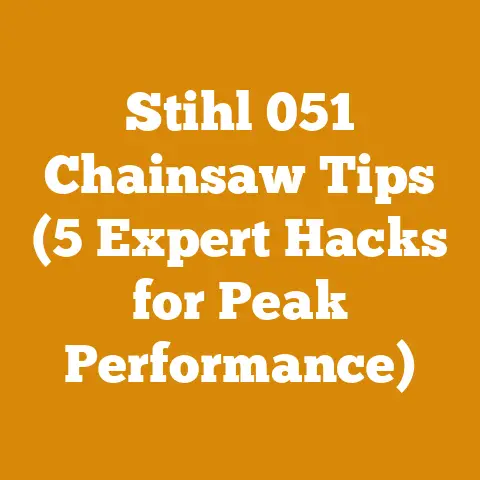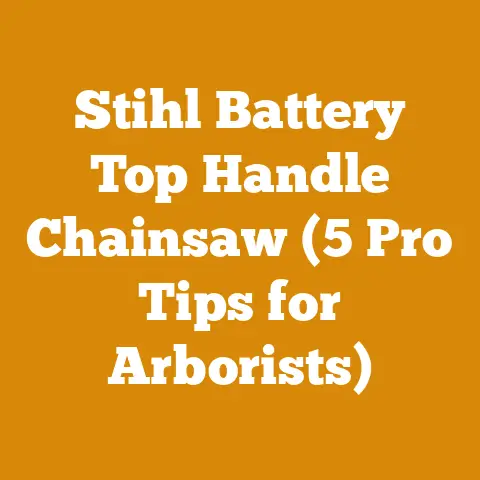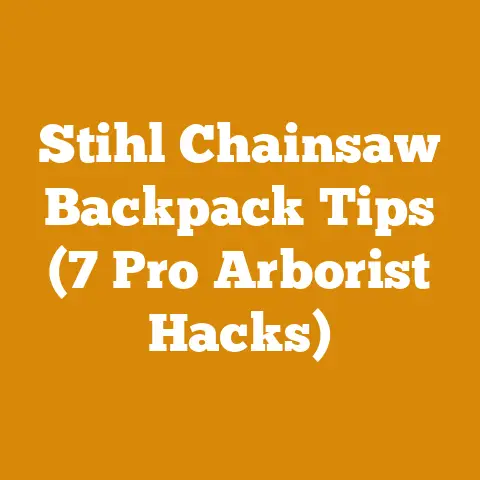Carpenter Bees Woodpeckers Control (Expert Tips for Woodworkers)
Ever noticed those perfectly round holes in your deck, fence, or even the beams of your shed? Or perhaps you’ve been driven nearly mad by the incessant drumming on your siding? You’re likely dealing with carpenter bees and woodpeckers, a frustrating duo for any woodworker or homeowner. As someone who’s spent years knee-deep in sawdust and timber, I’ve battled these pests firsthand, and I’m here to share my hard-earned knowledge. This article will delve into effective strategies for carpenter bee and woodpecker control, specifically tailored for those of us who work with wood regularly.
Understanding the Threat: Carpenter Bees and Woodpeckers
Before we jump into solutions, it’s crucial to understand our adversaries. Carpenter bees and woodpeckers are very different creatures, but their impact on our wooden structures can be equally damaging.
Carpenter Bees: Silent Destroyers of Wood
Carpenter bees, often mistaken for bumblebees, are solitary insects that bore into wood to create nests. Unlike termites, they don’t eat the wood; they simply excavate tunnels to lay their eggs. While a single carpenter bee might not cause significant damage, repeated infestations over time can weaken wooden structures, leading to costly repairs.
- Identification: Carpenter bees are large, black, and shiny, often with a metallic sheen. A key difference from bumblebees is their smooth, hairless abdomen.
- Damage: Look for perfectly round entrance holes, typically about 1/2 inch in diameter. These holes are often accompanied by piles of sawdust (frass) beneath them.
- Preferred Wood: They prefer softwoods like cedar, pine, redwood, and fir, but they will also attack hardwoods if they’re weathered or unfinished. I’ve personally seen them bore into pressure-treated lumber, although it’s less common.
- Life Cycle: Carpenter bees emerge in the spring, mate, and begin nesting. The females lay eggs in individual cells within the tunnels, providing each larva with a pollen ball for sustenance. The larvae develop into adults by late summer, and the new generation overwinters in the nests before emerging the following spring.
Woodpeckers: Nature’s Demolition Crew
Woodpeckers are birds known for their drumming on trees and wooden structures. While they primarily feed on insects, they also create holes in wood for nesting, roosting, or simply to attract mates. Their pecking can cause significant structural damage, especially to siding, trim, and wooden beams.
- Identification: Woodpeckers come in various sizes and colors, but they all share a characteristic long, pointed beak and strong neck muscles. Common species include the downy woodpecker, hairy woodpecker, and northern flicker.
- Damage: Woodpecker damage is usually characterized by irregular holes or pecking patterns. They may create small, exploratory holes or large cavities for nesting.
- Reasons for Pecking: Woodpeckers may peck for insects, to create nesting cavities, to establish territory (drumming), or simply out of curiosity. I’ve noticed that woodpeckers are more likely to attack wood that is already infested with insects, providing them with a readily available food source.
- Seasonal Activity: Woodpecker activity is typically highest during the spring and fall, coinciding with breeding season and migration.
Integrated Pest Management: A Holistic Approach
Effective carpenter bee and woodpecker control requires an integrated pest management (IPM) approach. This means combining various strategies to prevent and manage infestations, minimizing the use of harsh chemicals and maximizing long-term effectiveness.
1. Prevention: The First Line of Defense
Prevention is always better than cure. By taking proactive steps, you can significantly reduce the risk of carpenter bee and woodpecker damage.
- Wood Treatment and Sealing: Applying a high-quality sealant or paint to all exposed wood surfaces is one of the most effective preventative measures. Sealants create a barrier that makes it more difficult for carpenter bees to bore into the wood and less attractive to woodpeckers.
- Product Recommendations: I recommend using oil-based primers followed by two coats of exterior-grade acrylic latex paint. For natural wood finishes, consider using penetrating oil-based sealants with UV inhibitors.
- Application Techniques: Ensure that the wood is clean and dry before applying any treatment. Apply the sealant or paint evenly, paying close attention to cracks, joints, and end grain. Reapply every 2-3 years, or as needed, to maintain protection.
- Case Study: On a recent project building a cedar pergola, I treated all the wood with a penetrating oil-based sealant before assembly. This not only enhanced the natural beauty of the wood but also provided a protective barrier against carpenter bees and woodpeckers. After two years, the pergola remains free of any pest damage.
- Wood Selection: Choosing naturally resistant wood species can also help deter pests.
- Naturally Resistant Woods: Cedar, redwood, and cypress contain natural oils that make them less attractive to carpenter bees and woodpeckers. However, even these woods can be susceptible to attack if they are weathered or unfinished.
- Pressure-Treated Lumber: Pressure-treated lumber is resistant to decay and insect damage, but it is not immune to carpenter bees and woodpeckers. While the chemicals used in pressure treatment can deter some pests, they may still bore into the wood if other options are limited.
- Personal Experience: I’ve found that using a combination of naturally resistant wood and sealant provides the best protection against carpenter bees and woodpeckers. For example, I built a raised garden bed using cedar planks and treated them with a sealant. This has proven to be a very effective way to protect the wood from pest damage.
- Remove Decaying Wood: Carpenter bees are attracted to decaying or weathered wood. Removing and replacing any damaged or rotting wood can help prevent infestations.
- Inspection Checklist: Regularly inspect your wooden structures for signs of decay, such as soft spots, cracks, or discoloration. Pay close attention to areas that are exposed to moisture, such as decks, fences, and siding.
- Proper Disposal: Dispose of any decaying wood properly to prevent it from becoming a breeding ground for carpenter bees. Burn it (where permitted), bury it, or take it to a landfill.
- Maintain a Clean Environment: Keep your yard and wooden structures clean and free of debris. Remove any standing water, which can attract insects that woodpeckers may feed on.
- Yard Maintenance Tips: Mow your lawn regularly, trim shrubs and trees, and remove any piles of leaves or wood scraps. Ensure that your gutters are clean and functioning properly to prevent water from accumulating around your wooden structures.
2. Direct Control: Addressing Existing Infestations
If you already have carpenter bees or woodpeckers causing damage, you’ll need to take direct control measures to eliminate the pests and prevent further damage.
Carpenter Bee Control
- Dusting Entrance Holes: Applying insecticide dust directly into the entrance holes is an effective way to kill carpenter bees.
- Recommended Insecticides: I recommend using products containing deltamethrin, cyfluthrin, or permethrin. These insecticides are effective against carpenter bees and have a relatively low toxicity to humans and pets when used according to the label instructions.
- Application Techniques: Use a duster to puff the insecticide dust into the entrance holes. Apply the dust in the early morning or late evening, when the bees are less active. Wear gloves and a dust mask to protect yourself from exposure to the insecticide.
- Personal Experience: I’ve found that using a bulb duster with an extension nozzle is the most effective way to apply insecticide dust into carpenter bee holes. The extension nozzle allows you to reach the back of the tunnels, ensuring that the bees come into contact with the insecticide.
- Sealing Entrance Holes: After treating the entrance holes with insecticide dust, seal them to prevent carpenter bees from re-nesting.
- Sealing Materials: Use caulk, wood filler, or wooden dowels to seal the entrance holes. Make sure the sealing material is paintable so you can match the color of the surrounding wood.
- Timing: Wait a few days after applying the insecticide dust before sealing the holes. This will give the insecticide time to kill any remaining bees inside the tunnels.
- Case Study: On a recent project, I had a client with a severe carpenter bee infestation in their deck. I treated all the entrance holes with deltamethrin dust and then sealed them with caulk. After a few weeks, there was no more carpenter bee activity.
- Carpenter Bee Traps: Carpenter bee traps are a non-toxic way to capture and kill carpenter bees.
- How They Work: Carpenter bee traps typically consist of a wooden box with a small entrance hole and a clear plastic container attached to the bottom. The bees are attracted to the trap by the scent of wood and the presence of other bees. Once inside the trap, they are unable to escape and eventually die.
- Placement: Place carpenter bee traps near areas where you have seen carpenter bee activity. Hang them from eaves, fences, or trees.
- Effectiveness: Carpenter bee traps can be effective at reducing carpenter bee populations, but they are not a complete solution. They work best when used in conjunction with other control methods, such as insecticide dust and sealing entrance holes.
- Professional Pest Control: For severe infestations, it may be necessary to hire a professional pest control company.
- Benefits of Professional Treatment: Professional pest control companies have the expertise and equipment to effectively eliminate carpenter bee infestations. They can also provide long-term preventative measures to protect your property from future infestations.
- Choosing a Pest Control Company: When choosing a pest control company, make sure they are licensed and insured. Ask for references and read online reviews. Get a written estimate before hiring them.
Woodpecker Control
- Visual Deterrents: Woodpeckers are easily startled by visual deterrents.
- Types of Visual Deterrents: Hang shiny objects, such as aluminum foil strips, CDs, or reflective tape, near areas where woodpeckers are causing damage. You can also use scarecrows or inflatable owls.
- Placement: Place visual deterrents in areas where woodpeckers are active, such as near siding, trim, or wooden beams.
- Effectiveness: Visual deterrents can be effective at scaring away woodpeckers, but they may become habituated to them over time. It’s important to move the deterrents around regularly to keep the woodpeckers on edge.
- Auditory Deterrents: Woodpeckers are also sensitive to loud noises.
- Types of Auditory Deterrents: Use noisemakers, such as wind chimes, radios, or ultrasonic devices, to scare away woodpeckers. You can also bang on pots and pans or clap your hands.
- Timing: Use auditory deterrents during the times of day when woodpeckers are most active, such as early morning and late afternoon.
- Considerations: Be mindful of your neighbors when using auditory deterrents. Avoid using them at night or during quiet hours.
- Physical Barriers: Covering vulnerable areas with netting or wire mesh can prevent woodpeckers from accessing the wood.
- Types of Physical Barriers: Use bird netting or wire mesh to cover siding, trim, or wooden beams. Attach the netting or mesh securely to the structure.
- Installation: Make sure the netting or mesh is taut and covers the entire area that you want to protect. Leave enough space between the netting or mesh and the wood to prevent woodpeckers from pecking through it.
- Case Study: I had a client with a woodpecker problem on their cedar siding. I installed bird netting over the affected areas, and the woodpeckers stopped pecking immediately.
- Woodpecker Feeders: Providing woodpeckers with an alternative food source can help distract them from pecking on your wooden structures.
- Types of Woodpecker Feeders: Use suet feeders or feeders filled with nuts or seeds that woodpeckers enjoy.
- Placement: Place the feeders away from your wooden structures to encourage the woodpeckers to feed on the feeders instead of your wood.
- Personal Experience: I’ve found that providing woodpeckers with a suet feeder can be an effective way to reduce woodpecker damage. The suet provides them with a readily available source of protein, which can help satisfy their hunger and reduce their need to peck on wood.
- Professional Bird Control: For persistent woodpecker problems, it may be necessary to hire a professional bird control company.
- Benefits of Professional Treatment: Professional bird control companies have the expertise and equipment to effectively deter woodpeckers from your property. They can also provide long-term preventative measures to protect your property from future damage.
- Choosing a Bird Control Company: When choosing a bird control company, make sure they are licensed and insured. Ask for references and read online reviews. Get a written estimate before hiring them.
3. Repairing Damage: Restoring Structural Integrity
After you’ve eliminated the pests, it’s important to repair any damage they’ve caused to your wooden structures.
- Filling Holes: Fill carpenter bee holes and woodpecker holes with wood filler, caulk, or wooden dowels.
- Materials: Use a high-quality wood filler or caulk that is paintable and weather-resistant. For larger holes, consider using wooden dowels to provide additional support.
- Techniques: Clean the holes thoroughly before filling them. Apply the filler or caulk in thin layers, allowing each layer to dry completely before applying the next. Sand the filler or caulk smooth after it has dried.
- Replacing Damaged Wood: If the damage is extensive, you may need to replace the affected wood.
- Wood Selection: Choose wood that is similar in species and dimensions to the original wood. Consider using naturally resistant wood species or pressure-treated lumber for added protection.
- Installation: Cut the replacement wood to the correct size and shape. Attach it securely to the structure using nails, screws, or adhesive.
- Reinforcing Weakened Structures: If carpenter bee or woodpecker damage has weakened a wooden structure, you may need to reinforce it.
- Reinforcement Techniques: Use metal brackets, straps, or plates to reinforce weakened joints or beams. You can also add additional supports to the structure.
- Professional Assistance: For complex repairs or reinforcements, it’s best to consult with a qualified carpenter or contractor.
Safety Considerations: Protecting Yourself and the Environment
When dealing with carpenter bees and woodpeckers, it’s important to take safety precautions to protect yourself and the environment.
- Personal Protective Equipment (PPE): Wear gloves, a dust mask, and eye protection when applying insecticides or working with wood.
- Glove Selection: Choose gloves that are chemical-resistant and provide adequate protection for your hands.
- Dust Mask Selection: Use a NIOSH-approved dust mask to protect yourself from inhaling insecticide dust or wood particles.
- Eye Protection: Wear safety glasses or goggles to protect your eyes from flying debris or chemical splashes.
- Insecticide Safety: Follow the label instructions carefully when using insecticides. Store insecticides in a safe place, out of reach of children and pets.
- Label Instructions: Read and understand the label instructions before using any insecticide. Pay close attention to the recommended application rates, safety precautions, and first aid instructions.
- Storage: Store insecticides in a locked cabinet or shed, away from food, water, and other household items.
- Disposal: Dispose of empty insecticide containers properly, according to the label instructions.
- Ladder Safety: Use a sturdy ladder when working at heights. Make sure the ladder is properly positioned and secured before climbing.
- Ladder Selection: Choose a ladder that is appropriate for the height of the work you are doing. Use a stepladder for lower heights and an extension ladder for higher heights.
- Positioning: Place the ladder on a level surface and make sure it is stable. Extend the ladder at least 3 feet above the landing surface.
- Securing: Secure the ladder to the structure using ladder stabilizers or tie-down straps.
- Environmental Considerations: Avoid using harsh chemicals that can harm beneficial insects, birds, or other wildlife. Use integrated pest management techniques to minimize the impact on the environment.
- Non-Toxic Alternatives: Consider using non-toxic alternatives to insecticides, such as carpenter bee traps or visual deterrents.
- Targeted Application: Apply insecticides only to the areas where carpenter bees or woodpeckers are causing damage. Avoid spraying insecticides indiscriminately over your entire property.
Strategic Insights for Woodworkers
As woodworkers, we have a unique perspective on carpenter bee and woodpecker control. We understand the properties of wood, the construction techniques that make structures vulnerable, and the importance of protecting our creations from damage. Here are some strategic insights that can help you prevent and manage carpenter bee and woodpecker problems:
- Design for Prevention: When designing wooden structures, consider incorporating features that make them less attractive to carpenter bees and woodpeckers.
- Avoid Exposed End Grain: Carpenter bees prefer to bore into the end grain of wood. Design your structures to minimize the amount of exposed end grain.
- Use Angled Surfaces: Woodpeckers are less likely to peck on angled surfaces. Design your structures with angled siding or trim.
- Incorporate Metal Flashing: Metal flashing can protect vulnerable areas from carpenter bees and woodpeckers. Install metal flashing around windows, doors, and other openings.
- Proper Construction Techniques: Use proper construction techniques to ensure that your wooden structures are strong and durable.
- Use Quality Fasteners: Use high-quality nails, screws, or bolts to fasten wood together.
- Apply Sealant to Joints: Apply sealant to all joints to prevent water from entering and causing decay.
- Ensure Proper Drainage: Ensure that your wooden structures have proper drainage to prevent water from accumulating and attracting pests.
- Regular Maintenance: Regularly inspect your wooden structures for signs of carpenter bee or woodpecker damage. Repair any damage promptly to prevent it from getting worse.
- Inspection Schedule: Inspect your wooden structures at least twice a year, in the spring and fall.
- Repair Log: Keep a log of any repairs you make to your wooden structures. This will help you track any recurring problems and identify areas that may need additional attention.
Conclusion: Protecting Your Woodworking Investments
Carpenter bees and woodpeckers can be a frustrating and damaging problem for woodworkers and homeowners alike. By understanding the behavior of these pests and implementing an integrated pest management approach, you can effectively prevent and manage infestations. Remember to prioritize prevention, take direct control measures when necessary, repair any damage promptly, and always prioritize safety.
I’ve shared my experiences and insights from years of working with wood, and I hope this guide has provided you with the knowledge and tools you need to protect your woodworking investments. Now, armed with this information, you can take proactive steps to safeguard your wooden structures and enjoy them for years to come.
Next Steps: Putting Knowledge into Action
Ready to take action? Here are some practical next steps you can take to protect your wooden structures from carpenter bees and woodpeckers:
- Inspect your property: Conduct a thorough inspection of your wooden structures for signs of carpenter bee or woodpecker damage.
- Identify vulnerable areas: Identify areas that are particularly susceptible to attack, such as exposed end grain, softwoods, and areas with existing damage.
- Implement preventative measures: Apply sealant to all exposed wood surfaces, remove decaying wood, and maintain a clean environment.
- Take direct control measures: If you find evidence of carpenter bees or woodpeckers, take immediate action to eliminate the pests and prevent further damage.
- Repair any damage: Repair any damage caused by carpenter bees or woodpeckers promptly.
- Monitor your property: Regularly monitor your property for signs of new infestations.
By taking these steps, you can protect your woodworking investments and enjoy your wooden structures for years to come. Good luck, and happy woodworking!






